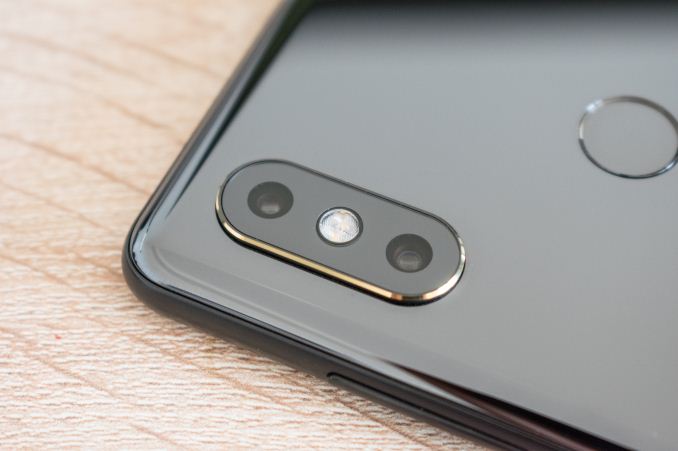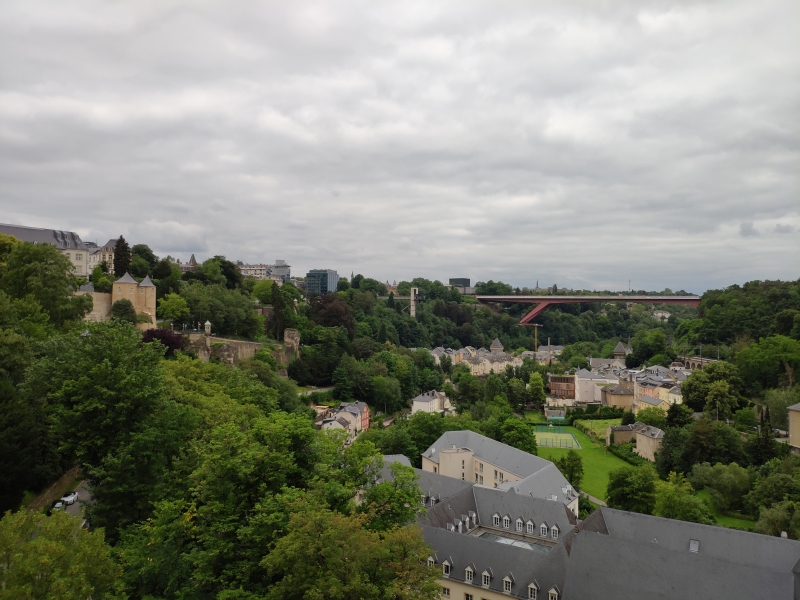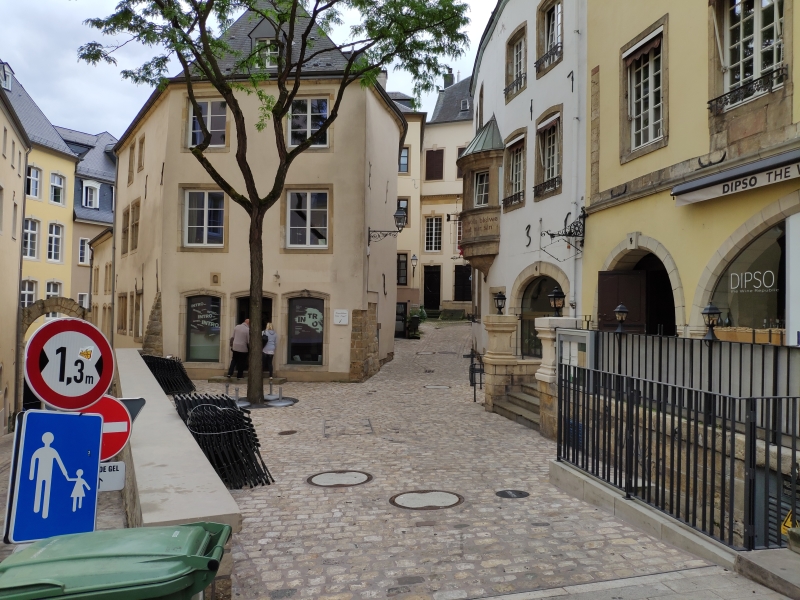The Xiaomi Mi MIX 2S Review: Fantastic Overall Value
by Andrei Frumusanu on June 29, 2018 8:00 AM EST- Posted in
- Mobile
- Smartphones
- Xiaomi
- MI MIX 2S
Camera - Daylight Evaluation
The Mi MIX 2S’s sports a completely new camera system over the MIX 2. The rear camera migrates from its central position above the fingerprint sensor to the side corner of the device – adopting the same camera housing design as first introduced by the iPhone X and subsequently carried over to many other designs from other vendors. The main sensor remains at a 12MP resolution, but the sensor size from Sony increases as we move from 1.25µm pixel pitch to 1.4µm pixels. The aperture as well increases from F/2.0 to F/1.8. Alongside the standard module we now also see a zoom module – this is a small 12MP sensor from Samsung with only 1µm pixels as well as a comparatively small F/2.4 aperture.
Xiaomi’s camera application is no-nonsense and offers a very straightforward capturing experience. In contrast to my last review where I covered the Huawei P20 and P20 Pro this is a complete opposite design philosophy and Xiaomi embraces the KISS principle (Keep it simple, stupid), and essentially beyond a toggle for an “AI” button, you won’t ever have to mess around with capturing modes as the defaults will always give the best results, as it should be.
In the daylight shots we’re looking at an overcast day – although this scenario should be relatively easy for smartphone cameras as we have far less dynamic brightness in the scene, we still see that phones have had issues in terms of exposure and HDR processing for the correct target levels.
[ Mi MIX 2S ]
[ P20 Pro ]
[ P20 ] - [ P10 ] - [ Mate 10 Pro ]
[ Galaxy S9+ ] - [ iPhone X ] - [ Pixel 2 XL ]
The MIX 2S captures were in my opinion among the best as it offered the most balanced exposure and HDR processing in terms of bringing out details in the greenery without overdoing it like many of the competing phones. While exposure and HDR processing was good – the MIX 2S did oversaturate it just a bit too much, with the real scene still being closer to the Galaxy S9’s good take.
The MIX 2S also surprises in terms of detail – it seems to be really competing with the Galaxy S9 and Pixel 2 in this shot, although the latter two have more detail contrast. Xiaomi seems to have a very light touch in terms of detail processing as I essentially don’t really see any sharpening at all – and there are hints of noise in the picture.
In the telephoto shot with the 2x zoom lens, Xiaomi manages to get the best exposure and colour reproduction result among the 2x devices, only Huawei’s 3x sensor seems to best it. In terms of detail on the zoom lens, it also competes favourably although there’s some blur. Here although the iPhone X produced the noisiest picture, it also retained the most detail. Huawei’s 3x zoom still obviously wins due to the optical magnification and also has very clean detail retention.
[ Mi MIX 2S ]
[ P20 Pro ]
[ P20 ] - [ P10 ] - [ Mate 10 Pro ]
[ Galaxy S9+ ] - [ iPhone X ] - [ Pixel 2 XL ]
In this shot the MIX 2S does a great job at exposure and HDR – with again the same characteristic that it’s oversaturating a tad too much. Both Samsung and Apple’s picture are too dark, while the other phones all have different issues in terms of processing to deal with.
The MIX 2S also did fantastic in terms of detail retention as it manages to get most out of the whole picture, clock tower including foreground foliage.
In the telephoto shots, the 2S didn’t do quite as good in terms of exposure as it balanced too much for the foreground instead of the clock tower. This resulted on not too great exposure on the target object. The iPhone X had the best 2x zoom result, while the P20 Pro had the best maximum zoom result with best noise and detail retention.
[ Mi MIX 2S ]
[ P20 Pro ] - [ P20 ]
[ P10 ] - [ Mate 10 Pro ]
[ Galaxy S9+ ] - [ iPhone X ] - [ Pixel 2 XL ]
The next scene again sees the MIX 2S do excellent exposure balance with seemingly again too much saturation. I could see why some people might prefer Xiaomi’s result, but that’s a subjective matter.
Detail retention again is outstanding on the MIX 2S, with essentially no really visible sharpening in the image, which is immensely helpful in maintaining the foliage throughout the whole scene, although the S9 does produce a much sharper image, even if it’s slightly more artificial.
The zoom shot in these scene seemed slightly underexposed for the MIX 2S, although colour rendition is excellent and doesn’t suffer from the oversaturation of the regular wide shot. In terms of detail retention the MIX 2S did better than the S9, but loses out to the iPhone X. Here we might see some of the limitations of the small 1µm sensor on the zoom module of the 2S as it has trouble with detail retention and noise. The P20 Pro’s 3x zoom module is still king in terms of telephoto quality.
[ Mi MIX 2S ]
[ P20 Pro ] - [ P20 ] - [ P10 ] - [ Mate 10 Pro ]
[ Galaxy S9+ ] - [ iPhone X ] - [ Pixel 2 XL ]
Exposure seems to be the MIX 2S’s camera forte, and the difference in processing choices is very visible in this shot. Xiaomi produces a much softer and natural image, while Samsung and Apple are trying to bring out more highlights. The iPhone X seems to overdo the HDR processing and thus loses dynamic range in the darker areas. Samsung opted for a higher exposure overall so the picture is brighter.
Detail wise the MIX 2S certainly isn’t the best as the S9 from Samsung just has more contrast over the whole scene, but the 2S still performs very respectably and produces a very natural look as it avoids any sharpening post-processing.
This is also an excellent scene to demonstrate the difference to the AI pictures – overall what the toggle seems to is to apply different colour and saturation levels depending what it detects in the scene. The exposure remains the same so overall the only change here is the post-processing, making the picture’s colours more saturated and pop a little more. I do think Xiaomi is taking a balanced approach here and the result can be subjectively more attractive to users if they so wish such a result.
[ Mi MIX 2S ]
[ P20 Pro ]
[ P20 ] - [ P10 ] - [ Mate 10 Pro ]
[ Galaxy S9+ ] - [ iPhone X ] - [ Pixel 2 XL ]
This scene again we see good exposure balance from the MIX 2S, although it’s not as great as previous scenarios. Here the MIX 2S opts for a very short exposure, and the disadvantage can be seen in the shadows as it’s retaining less dynamic range than the competition. Colour-wise, it’s still on the saturated side. Funnily enough if you go through the shots from Apple to Samsung to Xiaomi you’ll see the increasing colour saturations.
Detail wise again, Xiaomi keeps it very natural and that works out in the brighter objects in the scene, but loses out in the shadows due to less dynamic range captured.
The telephoto shot had a much different exposure and avoid the lack of details in the shadows. The result did seem overall too flat though as it’s trying to capture more of the sky instead of the foreground, thus giving Samsung and Apple an advantage in terms of dynamic range in the highlights.
Detail wise the MIX 2S is neck-in-neck with the iPhone X and beating the S9’s telephoto result, so the better picture is solely judged on exposure results, which I would give it to the iPhone. Naturally the P20 Pro still wins by sheer quality of the increased magnification while retaining excellent exposure balance.
[ Mi MIX 2S ]
[ P20 Pro ] - [ P20 ] - [ P10 ] - [ Mate 10 Pro ]
[ Galaxy S9+ ] - [ iPhone X ] - [ Pixel 2 XL ]
In this alley shot the MIX 2S compares most closely to the Pixel 2 XL in terms of exposure balance, while being just a little brighter in the shadows. Overall it’s an excellent representation of the scene, even though Samsung and Apple have more contrast and brighter highlights.
Detail wise the MIX 2S doesn’t do as well here as it’s lacking definition and contrast to bring out details throughout the scene. It has the most similar processing to the iPhone X, but the latter just retains more detail overall.
[ Mi MIX 2S ]
[ P20 Pro ] - [ P20 ] - [ P10 ] - [ Mate 10 Pro ]
[ Galaxy S9+ ] - [ iPhone X ] - [ Pixel 2 XL ]
In the last scene, the MIX 2S again results in great exposure balance, although it’s not as bright as some of the competition. The AI feature again can help to bring out more colours by increasing saturation and contrast. Xiaomi’s choice of applying little noise reduction comes in favour of the MIX 2S as I feel it retains better details than the iPhone X, falling only short of the S9.
Overall in terms of daylight capture, I was very impressed by the Mi MIX 2S due to mainly one factor: it had one of the most consistent shooting experiences out of the range of current phones I’ve tested. Exposure balance and dynamic range retention was most of the time above that of other devices. Detail retention, while it does lose in some scenarios to the S9 and iPhone X, is still very good, and Xiaomi’s choice of staying with a softer, more natural look in the images can be beneficial as it doesn’t fall to the double-edged sword that is post-processed sharpening.
The telephoto lens on the MIX 2S is good – I think it does beat the S9’s in terms of consistency and balance between exposure and detail, and it also has more natural saturation compared to the wide camera. I still prefer the iPhone X’s telephoto, and naturally the P20 Pro’s zoom lens is a step above the competition.
Lastly, the AI feature, unlike Huawei’s implementation on the P20’s – is actually non-detrimental on the MIX 2S. It offers an alternative colour palette and more saturations without overdoing it, and I can see it being popular with certain users.


















61 Comments
View All Comments
icalic - Monday, July 2, 2018 - link
Hi @Andrei Frumusanu,why no more gfxbench manhattan es 3.1 / metal test for battery life and final frame rate @ 150 nits?
i think that test is good for us to look GPU efficiency on every device.
icalic - Monday, July 2, 2018 - link
sorry, i meant @ nitsicalic - Monday, July 2, 2018 - link
@200 nits lolHolliday75 - Tuesday, July 3, 2018 - link
Third time is the charm!hisipo - Tuesday, July 3, 2018 - link
mynkl blUtilityMax - Monday, August 6, 2018 - link
No 3.5mm jack, no deal from me point. I would rather use a Moto G6 with SD450 but still have a 3.5mm connector.Fidelator - Sunday, September 2, 2018 - link
Andrei, I have to say that I am impressed by the quality of the latest batch of reviews, truly outstanding, the small one or two paragraph conclusion at the end of each section ia also extremely useful when you want to quickly check the performance of a devic3 in any given area.The newly introduced Speaker quality segment is quite simply, brilliant.
Great review, keep up the great work.
Now, these phones offer so much Bang for the buck that you'd be hard pressed to find any reason spend $700, $800 or $1000 on a phone, the Note 9 comes to mind as it is the one device that really checks all boxes with even some extra and unique bella and whistles but nithing else seems adequate at that point with this or the Pocophone in the market.
harshale7 - Saturday, October 6, 2018 - link
Reliance Jio is also said to be eyeing the telecom towers and optic fibre network of the cash-strappedphone services provider — assets that Canadian pension fund Brookfield, and a clutch of private equity
firms have also shown interest in, said one of the sources.
The joint lenders forum (JLF), which met in Mumbai on Thursday, discussed the sale of assets of the
telecommunications firm and a proposal to convert RCom’s debt into equity.
<a href="https://jiophone4g.com/"> jio tv </a>
<a href="https://jiophone4g.com/">jio dth</a>
<a href="https://jiophone4g.com/"> Jio Tv Web</a>
harshale7 - Saturday, October 6, 2018 - link
Reliance Jio is also said to be eyeing the telecom towers and optic fibre network of the cash-strappedphone services provider — assets that Canadian pension fund Brookfield, and a clutch of private equity
firms have also shown interest in, said one of the sources.
The joint lenders forum (JLF), which met in Mumbai on Thursday, discussed the sale of assets of the
telecommunications firm and a proposal to convert RCom’s debt into equity.
https://jiophone4g.com/
Archipelago - Wednesday, October 17, 2018 - link
I took the full size images from the Mi Max 2s review and edited them a little in Photoshop, the compared them to Galaxy S9 samples. With a little tweaking they were almost the same quality. As noted, the Xiaomi does not do that much sharpening compared to Samsung. I like that. It's almost like having a RAW image in which the user has control rather than the phone manufacturer. I hope you'll do a Mi 8 review. It seems like a Mi Max 2 with an AMOLED display.